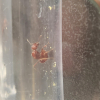- Formiculture.com
- Forums
- Gallery
- Members
- Member Map
- Chat

October 3 Wells NV
Started By
Vegiejack67
, Oct 3 2019 4:22 PM
6 replies to this topic
#1
 Offline
-
Posted October 3 2019 - 4:22 PM
Offline
-
Posted October 3 2019 - 4:22 PM
I caught this ant today. And I assumed it was just a worker and I hop I was correct. But it was one of the biggest ants I've seen in my town, and I was hoping someone could ID it so I can catch on during there flight next year.
http://imgur.com/gallery/zvLaXT5
http://imgur.com/gallery/zvLaXT5
#2
 Offline
-
Posted October 3 2019 - 4:34 PM
Offline
-
Posted October 3 2019 - 4:34 PM
Camponotus. These guys usually fly around may
My journals:
Polyergus Mexicanus: https://www.formicul...gs/#entry175528
Lasius minutus: https://www.formicul...cs/#entry174811
Lasius latipes: https://www.formicul...gs/#entry206449
General acanthomyops journal: https://www.formicul...yops-with-eggs/
Polyergus Mexicanus: https://www.formicul...gs/#entry175528
Lasius minutus: https://www.formicul...cs/#entry174811
Lasius latipes: https://www.formicul...gs/#entry206449
General acanthomyops journal: https://www.formicul...yops-with-eggs/
#3
 Offline
-
Posted October 3 2019 - 6:19 PM
Offline
-
Posted October 3 2019 - 6:19 PM
Camponotus vicinus. Now, if you live in an area near the Sierra Nevada mountains, on the Californian side, I have found a queen in August, with no workers or brood, so freshly flown. So, don't stop looking after April and May of next year.
Hi there! I went on a 6 month or so hiatus, in part due, and in part cause of the death of my colonies.
However, I went back to the Sierras, and restarted my collection, which is now as follows:
Aphaenogaster uinta, Camponotus vicinus, Camponotus modoc, Formica cf. aserva, Formica cf. micropthalma, Formica cf. manni, Formica subpolita, Formica cf. subaenescens, Lasius americanus, Manica invidia, Pogonomyrmex salinus, Pogonomyrmex sp. 1, Solenopsis validiuscula, & Solenopsis sp. 3 (new Sierra variant).
#4
 Offline
-
Posted October 4 2019 - 9:03 PM
Offline
-
Posted October 4 2019 - 9:03 PM
I actually live on the opposite side of Nevada unfortunately. However the the flights should be relatively similar as far as I know, correct?
#5
 Offline
-
Posted October 5 2019 - 6:53 AM
Offline
-
Posted October 5 2019 - 6:53 AM
I don't know. Are you in a high elevation area, ie, 8,000 feet?
Hi there! I went on a 6 month or so hiatus, in part due, and in part cause of the death of my colonies.
However, I went back to the Sierras, and restarted my collection, which is now as follows:
Aphaenogaster uinta, Camponotus vicinus, Camponotus modoc, Formica cf. aserva, Formica cf. micropthalma, Formica cf. manni, Formica subpolita, Formica cf. subaenescens, Lasius americanus, Manica invidia, Pogonomyrmex salinus, Pogonomyrmex sp. 1, Solenopsis validiuscula, & Solenopsis sp. 3 (new Sierra variant).
#6
 Offline
-
Posted October 5 2019 - 9:16 PM
Offline
-
Posted October 5 2019 - 9:16 PM
5600+-
#7
 Offline
-
Posted October 6 2019 - 5:29 AM
Offline
-
Posted October 6 2019 - 5:29 AM
Hmmm. I don't know. My guess is that they probably fly around the usual Camponotus flight time, maybe a little later. Just look hard next year.
Hi there! I went on a 6 month or so hiatus, in part due, and in part cause of the death of my colonies.
However, I went back to the Sierras, and restarted my collection, which is now as follows:
Aphaenogaster uinta, Camponotus vicinus, Camponotus modoc, Formica cf. aserva, Formica cf. micropthalma, Formica cf. manni, Formica subpolita, Formica cf. subaenescens, Lasius americanus, Manica invidia, Pogonomyrmex salinus, Pogonomyrmex sp. 1, Solenopsis validiuscula, & Solenopsis sp. 3 (new Sierra variant).
0 user(s) are reading this topic
0 members, 0 guests, 0 anonymous users
















